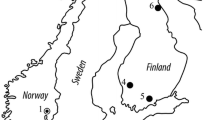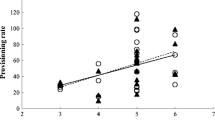Abstract
In birds with bi-parental care, the provisioning link between prey capture and delivery to dependent offspring is regarded as often symmetric between the mates. However, in raptors, the larger female usually broods and feeds the nestlings, while the smaller male provides food for the family, assisted by the female in the latter part of the nestling period, if at all. Prey items are relatively large and often impossible for nestlings to handle without extended maternal assistance. We video-recorded prey delivery and handling in nests of a raptor with a wide diet, the Eurasian kestrel Falco tinnunculus, and simultaneously observed prey transfer from male to female outside the nest. The male selectively allocated larger items, in particular birds and larger mammals, to the female for further processing and feeding of nestlings, and smaller items, in particular lizards and smaller mammals, directly to the nestlings for unassisted feeding. Hence, from the video, the female appeared to have captured larger prey than the male, while in reality no difference existed. The female’s size-biased interception of the male’s prey provisioning line would maximize the male’s foraging time, and maximize the female’s control of the allocation of food between her own need and that of the offspring. The male would maximize his control of food allocation by capturing smaller prey. This conflict would select for larger dominant females and smaller energy-efficient males, and induce stronger selection the longer the female depends on the male for self-feeding, as a proportion of the offspring dependence period.





Similar content being viewed by others
References
Aanonsen OM (2003) Prey handling and nestling interactions in the common buzzard, Buteo buteo. MSc thesis, Agricultural University of Norway, Ås
Andersen LI (2003) Food allocation from parent to offspring in the European sparrowhawk Accipiter nisus: impact of relative nestling size. Cand agric thesis, Agricultural University of Norway, Ås
Andersson M (1994) Sexual selection. Princeton University Press, Princeton
Andersson M, Norberg RÅ (1981) Evolution of reversed sexual size dimorphism and role partitioning among predatory birds, with a size scaling of flight performance. Biol J Linn Soc 15:105–130
Asakskogen E (2003) Short-term prey caching in nesting Tengmalm’s owl (Aegolius funereus). Cand agric thesis, Agricultural University of Norway, Ås
Boal CW, Mannan RW (1996) Prey sizes of male and female northern goshawks. Southwest Nat 41:355–358
Bolker BM, Brooks ME, Clark CJ, Geange SW, Poulsen JR, Stevens MHH, White J-SS (2009) Generalized linear mixed models: a practical guide for ecology and evolution. Trends Ecol Evol 24:127–135
Brodin A, Jönsson KI, Holmgren N (2003) Optimal energy allocation and behaviour in female raptorial birds during the nestling period. Ecoscience 10:140–150
Collopy MW (1984) Parental care and feeding ecology of golden eagle nestlings. Auk 101:753–760
Cramp S (1985) The birds of the western palearctic, vol IV. Oxford University Press, Oxford
Cramp S, Simmons KEL (1980) The birds of the western palearctic, vol II. Oxford University Press, Oxford
Davoren GK, Burger AE (1999) Difference in prey selection and behaviour during self-feeding and chick provisioning in rhinoceros auklets. Anim Behav 58:853–863
Dawson RD, Bortolotti GR (2002) Experimental evidence for food limitation and sex-specific strategies of American kestrels (Falco sparverius) provisioning offspring. Behav Ecol Sociobiol 52:43–52
Delannoy CA, Cruz A (1999) Patterns of prey abundance and use by male and female Puerto Rican sharp-shinned hawks. Caribb J Sci 35:38–45
Eldegard K, Sonerud GA (2009) Female offspring desertion and male-only care increase with natural and experimental increase in food abundance. Proc R Soc Lond B 276:1713–1721
Eldegard K, Sonerud GA (2010) Experimental increase in food supply influences the outcome of within-family conflicts in Tengmalm’s owl. Behav Ecol Sociobiol 64:815–826
Eldegard K, Sonerud GA (2012) Sex roles during post-fledging care in birds: female Tengmalm’s owls contribute little to food provisioning. J Ornithol 153:385–398
Eldegard K, Selås V, Sonerud GA, Steel C, Rafoss T (2003) The effect of parent sex on prey deliveries to fledgling Eurasian sparrow hawks Accipiter nisus. Ibis 145:667–672
Fargallo JA, Laaksonen T, Korpimäki E, Pöyri V, Griffith SC, Valkama J (2003) Size-mediated dominance and begging behaviour in Eurasian kestrel broods. Evol Ecol Res 5:549–558
Geer T (1981) Factors affecting the delivery of prey to nestling sparrowhawks (Accipiter nisus). J Zool 195:71–80
Grønnesby S, Nygård T (2000) Using time-lapse video monitoring to study prey selection by breeding goshawks Accipiter gentilis in central Norway. Ornis Fenn 77:117–129
Hinde CA, Kilner RM (2007) Negotiations within the family over the supply of parental care. Proc R Soc Lond B 274:53–60
Houston AI, Székely T, McNamara JM (2005) Conflict between parents over care. Trends Ecol Evol 20:33–38
Itämies J, Korpimäki E (1987) Insect food of the kestrel, Falco tinnunculus, during breeding in western Finland. Aquilo Ser Zool 25:21–31
Kelly EJ, Kennedy PL (1993) A dynamic state variable model of mate desertion in Cooper’s hawk. Ecology 74:351–366
Kennedy PL, Johnson DR (1986) Prey-size selection in nesting male and female Cooper’s hawks. Wilson Bull 98:110–115
Kenward R (2006) The goshawk. Poyser, London
Korpimäki E, Tolonen P, Valkama J (1994) Functional response and load-size effect in central place foragers: data from kestrels and some general comments. Oikos 69:504–510
Kristiansen L (2003) Prey preparation time by Tengmalm’s owl (Aegolius funereus) feeding nestlings. Cand scient thesis, Agricultural University of Norway, Ås
Krüger O (2005) The evolution of reversed sexual size dimorphism in hawks, falcons and owls: a comparative study. Evol Ecol 19:467–486
Løw LM (2006) Prey preparation and ingestion rate in breeding Eurasian kestrels Falco tinnunculus. MSc thesis, Norwegian University of Life Sciences, Ås
Massemin S, Korpimäki E, Wiehn J (2000) Reversed sexual size dimorphism in raptors: evaluation of the hypotheses in kestrels breeding in a temporally changing environment. Oecologia 124:26–32
McDonald PG, Olsen PD, Baker-Gabb DJ (2003) Territory fidelity, reproductive success and prey choice in the brown falcon, Falco berigora: a flexible bet-hedger? Aust J Zool 51:399–414
Mueller HC (1990) The evolution of reversed sexual dimorphism in size in monogamous species of birds. Biol Rev 65:553–585
Mueller HC, Mueller NS, Berger DD, Allez G, Robichaud WG (2000) Age and sex differences in the size of prey of the sharp-shinned hawk. J Field Ornithol 71:399–408
Newton I (1979) Population ecology of raptors. Poyser, Berkhamsted
Newton I (1986) The sparrowhawk. Poyser, Calton
Pinheiro JC, Bates DM (2000) Mixed-effects models in S and S-PLUS. Springer, New York
Poole A (1985) Courtship feeding and osprey reproduction. Auk 102:479–492
Poole KG, Boag DA (1988) Ecology of gyrfalcons, Falco rusticolus, in the central Canadian Arctic: diet and feeding behaviour. Can J Zool 66:334–344
R Development Core Team (2010) R: a language and environment for statistical computing. R Foundation for Statistical Computing, Vienna
Rands SA, Houston AI, Gasson CE (2000) Prey processing in central place foragers. J Theor Biol 202:161–174
Redpath SM, Leckie FM, Arroyo B, Amar A, Thirgood SJ (2006) Compensating for the cost of polygyny in hen harriers Circus cyaneus. Behav Ecol Sociobiol 60:386–391
Reif V, Tornberg R (2006) Using time-lapse digital video recording for a nesting study of birds of prey. Eur J Wildl Res 52:251–258
Selander RK (1966) Sexual dimorphism and differential niche utilization in birds. Condor 68:113–151
Slagsvold T (1997) Brood division in birds in relation to offspring size: sibling rivalry and parental control. Anim Behav 54:1357–1368
Slagsvold T, Sonerud GA (2007) Prey size and ingestion rate in raptors: importance for sex roles and reversed sexual size dimorphism. J Avian Biol 38:650–661
Slagsvold T, Sonerud GA, Grønlien HE, Stige LC (2010) Prey handling in raptors in relation to their morphology and feeding niches. J Avian Biol 41:488–499
Snyder NFR, Wiley JW (1976) Sexual size dimorphism in hawks and owls of North America. Ornithol Monograph no. 20
Sonerud GA (1989) Allocation of prey between self-consumption and transport in two different-sized central place foragers. Ornis Scand 20:69–71
Sonerud GA (1992) Functional responses of birds of prey: biases due to the load-size effect in central place foragers. Oikos 63:223–232
Steen R (2004) Food provisioning in the Eurasian kestrel (Falco tinnunculus): handling efficiency of prey delivered to the nest. Cand scient thesis, Agricultural University of Norway, Ås
Steen R (2010) Food provisioning in a generalist predator: selecting, preparing, allocating and feeding prey to nestlings in the Eurasian kestrel (Falco tinnunculus). PhD thesis, Norwegian University of Life Sciences, Ås
Steen R, Løw LM, Sonerud GA, Selås V, Slagsvold T (2010) The feeding constraint hypothesis: prey preparation as function of nestling age and prey mass in the Eurasian kestrel. Anim Behav 80:147–153
Steen R, Løw LM, Sonerud GA, Selås V, Slagsvold T (2011) Prey delivery rates as estimates of prey consumption by Eurasian kestrel (Falco tinnunculus) nestlings. Ardea 99:1–8
Steen R, Sonerud GA, Slagsvold T (2012) Parents adjust feeding effort and prey size in relation to nestling age in the Eurasian kestrel (Falco tinnunculus). J Ornithol 153:1087–1099
Sunde P, Bølstad MS, Møller JD (2003) Reversed sexual dimorphism in tawny owls, Strix aluco, correlates with duty division in breeding effort. Oikos 101:265–278
Temeles EJ (1985) Sexual size dimorphism of bird-eating hawks: the effect of prey vulnerability. Am Nat 125:485–499
Tolonen P, Korpimäki E (1995) Parental effort of kestrels (Falco tinnunculus) in nest defence: effects of laying date, brood size, and varying survival prospects of offspring. Behav Ecol 6:435–441
Tornberg R, Reif V (2007) Assessing the diet of birds of prey: a comparison of prey items found in nests and images. Ornis Fenn 84:21–31
Village A (1990) The kestrel. Poyser, London
Wiehn J, Korpimäki E (1997) Food limitation on brood size: experimental evidence in the Eurasian kestrel. Ecology 78:2043–2050
Ydenberg RC (1994) The behavioral ecology of provisioning in birds. Ecoscience 1:1–14
Ydenberg RC (2007) Provisioning. In: Stephens DW, Brown JS, Ydenberg RC (eds) Foraging: behavior and ecology. University Chicago Press, Chicago, pp 273–303
Ydenberg RC, Davies WE (2010) Resource geometry and provisioning routines. Behav Ecol 21:1170–1178
Acknowledgments
We are grateful to O.P. Blestad and B.E. Foyn for permitting us to film in their nest boxes, and to K. Eldegard, P.L. Kennedy, P. Sunde, C.J. Whelan, A. Zedrosser and two anonymous referees for their critical comments and suggestions for improvement of the analysis and the manuscript. The study received financial support from the Directorate for Nature Management and the Hedmark County Governor.
Conflict of interest
The authors declare that they have no conflict of interest.
Author information
Authors and Affiliations
Corresponding author
Additional information
Communicated by Chris Whelan.
Rights and permissions
About this article
Cite this article
Sonerud, G.A., Steen, R., Løw, L.M. et al. Size-biased allocation of prey from male to offspring via female: family conflicts, prey selection, and evolution of sexual size dimorphism in raptors. Oecologia 172, 93–107 (2013). https://doi.org/10.1007/s00442-012-2491-9
Received:
Accepted:
Published:
Issue Date:
DOI: https://doi.org/10.1007/s00442-012-2491-9




